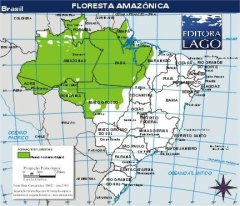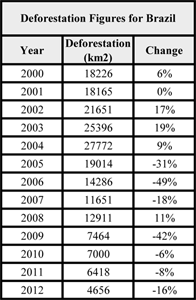Deforestation, Logging and Minning: a deadly combination for the Amazon rainforest.
Fig 1: Eco4u, 2011
The Amazon forest is the largest, and one of the most bio diverse rainforests in the world. It covers an area of 5.5 million square kilometers and is shared by nine countries, as shown by the yellow line in figure 1 , including: Brazil with the largest share at 68%; then Peru at 13%; Bolivia at 11% and Colombia at 6%. Venezuela, Ecuador, Guyana, Suriname and French Guiana also hold a small part of the forest. (Simpsons, 2009, p.1)
The green line on figure 1 shows the Amazon forest that lies within the Brazilian territory. As much as 59% of Brazil’s entire territory is part of the Amazon forest. The red line in figure 1 shows the area known as Legal Amazon (Amazônia Legal) that was created in 1953. This territorial boundary was established due to the need of economic growth in the region and therefore is not considered to be a part of the forest’s ecosystem. (IPEA, 2007)

Fig 2: Editora Lago, n.d
This area can be seen better in figure 2 where it shows that the forest comprises 8 whole Brazilian states: Acre, Amapá, Amazonas, Mato Grosso, Pará, Rondônia, Roraima and Tocantins, and is also present in a part of the state Maranhão. It is in these states that most indigenous groups reside with around 56% of the indigenous population. (IPEA, 2007)
The Amazon has one of the richest eco-systems in the world; according to Case it contains an average of “40,000 plant species, 427 mammals, 1294 birds, 378 reptiles, 427 amphibians, 3,000 fishes, and likely over a million insect species”. The Amazon basin also supports individuals with agriculture and silviculture[1] besides providing natural resources for the creation of medicines and materials used in construction. The Amazon river is a great source of freshwater and it represents 15 to 20% of universal river flow. (Case, n.d)
The Amazon Rainforest plays a key role in regulating the earth’s climate and is often referred as the lungs of the world due to its vast consumption of carbon dioxide and production of oxygen, without which the earth could not survive. As such, the survival of the Amazon is directly linked to the survival of the planet. However, despite this fact it is under threat from logging and farming. (WWF, n.d)
Threats
The Amazon is threatened by several activities such as deforestation, logging, mining, forest fires and road infrastructure. Over recent years the situation has improved but it is clear that a lot of work still needs to be done. Below there will be a short introduction to some of the threats that affect the Amazon forest.
Deforestation
Since the 1960s and 70s, deforestation in the rainforest, particularly in the Brazilian Amazon, has been very high mainly due to the greater access allowed by the construction of highways, such as the Trans Amazonian Highway, through the forest. Prior to 1970, the forested area of the Brazilian Amazon was 4,100,000km2; by 2008 it had been reduced to 3,375,000km2. (Simpsons, 2009, p.2)
Around 65 – 70% of the deforestation in the Amazon is caused mainly by cattle ranches, followed by local scale agriculture with 20 – 25%, commercial scale agriculture with 5 – 10%, logging with 2-3% and forest fires, mining, urbanization, construction of roads and dams with 1-2%. (Butler, 2012)
The graph below illustrates the level of deforestation from 1988 – 2012:

Fig 3: Butler, 2012
The rate of deforestation from 1988 – 2012 can be seen in figure 3. The highest peak of deforestation occurred in 1995 where, in comparison to the previous year, there was an increase of 95% with 29.095 square kilometers of forestland felled. The lowest point up until now was in 2012 where deforestation decreased by 16% in comparison to 2011, with only 4656km2 of the forest being logged.
Further detail can be seen in the table from 2000-2012:

Fig 4: INPE
Figure 4 shows the percentage of change in deforestation from 2000 – 2012 released by the INPE. High peaks were registered in 2002, 2003 and 2004. In 2005 there is a reduction of 31% in the level of deforestation. The figures from 2005 – 2012 show a further decrease in deforestation with the exception of 2008 where deforestation increased by 11%.
Historically, deforestation in Brazil has been closely linked with the country’s economy; a decline in the economy matches a decline in deforestation and vice versa. As Butler notes: “the decline in deforestation from 1988-1991 nicely matched the economic slowdown during the same period, while the rocketing rate of deforestation from 1993-1998 paralleled Brazil’s period of rapid economic growth”. (Butler, 2012)
Butler states that the reason for this is simply that in periods of economic stagnation or decline, ranchers and developers do not have the money to expand their land into rainforest territory and the government has no money to encourage them with tax breaks or highway developments. However, in the last decade the link between the Brazilian economy and rainforest deforestation has become less apparent. (Butler, 2012)
Unfortunately, since this article was written deforestation rose by 28% from August 2012 – July 2013 setting back decades of work. (BBC, 2013)
Logging
Logging refers to the process of cutting down trees and collecting the timber for commercial purposes. The impact that this activity has on the environment still needs to be evaluated properly due to the diverse methods in which logging can be executed. Logging, depending on how it is done, can lead to severe destruction. Illegal logging conducted without following the pre-approved procedures, tends to cause more harm to the environment since the land is often being cleared mainly for pasture. This destroys the equilibrium of the forest and makes it more vulnerable to fires. (Barreto et al., 2006)
Besides cattle ranchers clearing land for their livestock, the rainforest is also being targeted by international corporations and national companies for its wood. Illegal logging contributes a large amount to the overall deforestation of the Amazon with an average of 60-80% of all logging activities in the forest considered to be illegal. Such illegal loggers usually forge permits and cut down trees from preserved and indigenous areas without respecting the legal limitation. These activities are executed in small or moderate scale to make detection difficult. Loggers also take advantage of the fact that the governmental environment agency, IBAMA, is not very present due to the remoteness of the areas in which they work. (Greenpeace International, 2005)
Illegal loggers are also intelligent when it comes to covering their tracks, often using “legally approved forest operations in the Brazilian Amazon commonly provide cover for illegal logging. Logs are frequently cut illegally up river from approved operations and clandestinely floated downstream.” Once they arrive in an area that was approved for forestry activities the logs are legalized with fake documents declaring that they were cut legally. (Greenpeace International, 2005)
To counteract the illegal logging threat the Brazilian national space agency (INPE) launched a program called Deter in 2004 to monitor the Amazon forest live using satellites. Once a satellite detects an abnormal activity it emits a report directly to the Amazonian states so that they can take action against the criminals. The coordinates provided by the satellite are very precise. If the location is difficult to access the IBAMA officials go by helicopter. (Menezes, 2012)
Mining
The Amazon rainforest is rich in precious metals and according to the WWF, “copper, tin, nickel, bauxite, manganese, iron and gold” can be found within the forest and tax benefits are being offered by governments to encourage extraction projects to stimulate economies. The prediction is that mining in the Amazon will increase due to the technological advance in extractive knowledge combined with such monetary incentives. (WWF, n.d)
However, many of these extraction methods have an adverse effect on the natural environment. Mining in general often damages the environment; it contaminates water supplies and threatens small communities such as indigenous populations. Gold mining in particular can be especially damaging to local habitats as it often involves the use of hazardous chemicals such as Mercury. (Casey, 2009)
Mercury is a highly pollutant chemical that can cause serious illness in humans and is often found in high quantities around gold mining sites, having found its way into the local food and water supply, contaminating animals and subsequently the humans that eat them. (Casey, 2009) Additionally, once the raw material has been mined, it has to be melted down. This requires charcoal to fuel furnaces that is often sourced from the forest by cutting down trees. (Everyculture, n.d)
Mining activities also affect local populations by polluting the environment. For example, the Kayapó village of Gorotire started to suffer from the environmental consequences of the mining industry that had brought so much wealth. The rivers became polluted, sexually transmitted diseases and malaria increased and the tribe became reliant on food that was brought into the forest as they had reduced their hunting activities. In the 1990’s, indigenous women started to miscarriage or give birth to babies with health problems. This happened as a result of mercury contamination in the soil, water, air and food caused by mining. (Rabben, 2010)
Nowadays natural resources are becoming scarce and the Amazon forest has vast quantities of untapped raw materials such as plants, timber, gold and iron, all of which are currently being exploited illegally. It would be beneficial if the Brazilian government increased control and by patrolling the Amazon region illicit activities can be monitored closely.
The Amazon Rainforest is being plagued by numerous threats such as those mentioned above. As stated, the Brazilian government is taking actions to counteract these threats, but, with a few exceptions, it would seem that many of these measures are not producing the desired results.
*This Article is adapted from my master’s thesis: ‘Sustainable Development & Green Economy: the planet’s future or greening indigenous communities into oblivion?’ which was completed as part of the Master’s Curriculum at the Willy Brandt School of Public Policy in Erfurt, Germany.
*Cover image ‘Amazon forest’ by Lou Gold
[1] Silviculture refers to the cultivation of forests and trees. (Free Dictionary, n.d)

